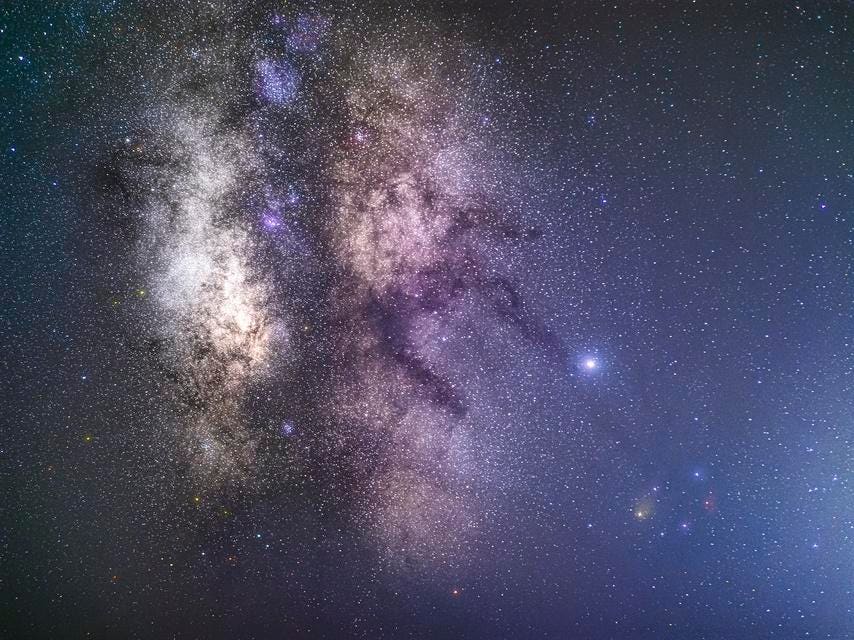August is a great month for the Milky Way.
getty
Each Monday, I pick out North America’s celestial highlights for the week ahead (which also apply to mid-northern latitudes in the Northern Hemisphere). Check my main feed for more in-depth articles on stargazing, astronomy, eclipses and more.
The Night Sky This Week: August 18-24, 2025
This week offers some stunning celestial lineup. The highlight is a beautiful “planet parade” featuring Mercury, Venus and Jupiter, which is graced by the crescent moon as it wanes. Here’s everything you need to know about the night sky this week:
Monday, August 18: ‘Planet Parade’ And A Crescent Moon
Stellarium
Monday, August 18: ‘Planet Parade’ And A Crescent Moon
Look east about an hour before sunrise to see the 26%-lit waning crescent moon sliding into a gathering of bright planets. Venus and Jupiter will shine brilliantly, while the keen-eyed will also see Mercury creeping up from the horizon.
Tuesday, August 19: ‘Planet Parade,’ Crescent Moon And Mercury
Stellarium
Tuesday, August 19: ‘Planet Parade,’ Crescent Moon And Mercury
Another early start — an hour before sunrise — will reveal a 16%-lit crescent moon, which will now be perched just above Jupiter and Venus. Since today marks Mercury’s greatest elongation west — its farthest point from the sun in the morning sky — it may be the best morning to see the tiny planet.
Wednesday, August 20: ‘Planet Parade’ And A Moon-Venus Conjunction
Stellarium
Wednesday, August 20: ‘Planet Parade’ And A Moon-Venus Conjunction
Is this the sky-watching highlight of the entire month? It will be hard to argue with the sight of a delicate 9%-lit crescent moon snuggling up to dazzling Venus in the eastern sky just before sunrise. Jupiter will hover above, with Mercury below.
Thursday, August 21: Moon, Mercury And the Beehive Cluster
Stellarium
Thursday, August 21: Moon, Mercury And the Beehive Cluster
The “planet parade” continues, but there’s something else going on close by. An incredibly slender 4%-lit crescent moon will shine just above Mercury. Those with binoculars will see, between the two, the Beehive Cluster (M44), a sparkling group of 100 stars.
Saturday, August 23: A ‘Black Moon’
Today is a new moon, but it has a strange name. The third new moon in a season of four is called a seasonal black moon by astronomers. Although not visible itself (a new moon is always roughly between the Earth and the sun), its absence means pristine, dark skies for late summer observation.
The Milky Way shines brightly in the night sky against a Saguaro cactus silhouette in the Sonoran Desert near Phoenix, Arizona.
getty
Stargazing Tip Of The Week: The Milky Way
With the moon out of the evening night sky, this week offers ideal conditions to observe the Milky Way immediately after dark. Look for it stretching from the southeastern sky up and over to the southwest. The galactic core, dense with stars and dust lanes, is low on the southern horizon. This is a good week to get to dark skies far from city lights.
Cygnus at the top to the Summer Triangl, with Aquila lower-left and Lyra beneath. .
getty
Constellation of the Week: Cygnus, ‘The Swan’
You know the Summer Triangle — three bright stars high in the southeast — that’s been visible for a few months and will be seen for a few more yet. One of those corner stars, Deneb, is also the brightest star in the constellation Cygnus, “The Swan,” which flies high overhead during summer nights. It glides along the plane of the Milky Way in an area rich with star fields and nebulae.
The times and dates given apply to mid-northern latitudes. For the most accurate location-specific information, consult online planetariums like Stellarium.
Wishing you clear skies and wide eyes.









